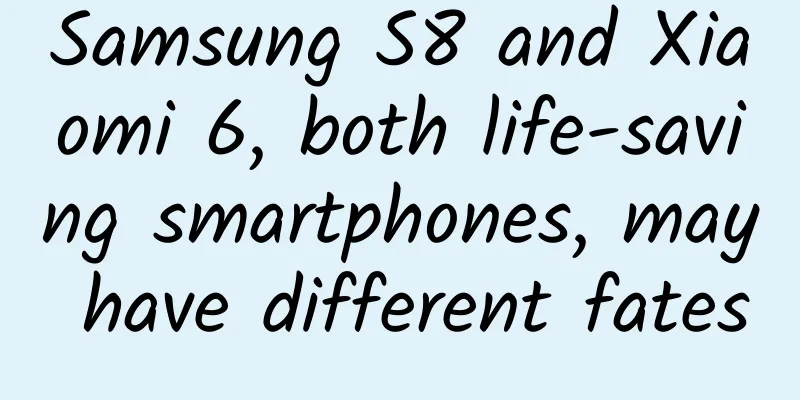Samsung S8 and Xiaomi 6, both life-saving smartphones, may have different fates

|
Samsung S8 will be released in China this month, and Lei Jun has also vowed to solve the production capacity bottleneck of Xiaomi 6. These two life-saving phones are of extraordinary significance to the two companies, but in the long run, they may not share the same fate despite having the same origin. According to data previously released by Samsung, the shipment volume of Note7, which was plagued by explosions and spontaneous combustion incidents, was only 3.09 million units. However, the S7 released in March last year still achieved 55 million shipments, and the pre-order volume of S8 increased by 30%, indicating that the Samsung brand was not hit hard. Most people tend to believe that Samsung just made two common sense mistakes at that time: The first is the rush to distribute the products before iPhone 7. On August 2 last year, Samsung released Note 7 before Apple's new autumn products and rushed to distribute them. In retrospect, this was its biggest failure. It not only allowed outsiders to see the fear and worry of Samsung's top management about iPhone 7, but also made things worse for others. On August 24, the first Note 7 exploded, and similar incidents occurred one after another. By September 2, Samsung had to announce a recall, and as a result, iPhone 7, which was released on September 8, became the biggest winner. The second is overconfidence in hardware quality. Several months later, Samsung announced the results of its investigation into the Note7 spontaneous combustion incident. Due to the overly radical industrial design, the battery compartment and the battery did not match, and the negative plate of the battery was squeezed, causing a short circuit between the positive and negative poles and a fire. Other reasons included the melting of the copper foil, burrs during the welding process piercing the insulating film, causing a short circuit and fire, and some batteries not using insulating tape. But the incident also confirmed from one side the resilience of the Samsung brand. The controversy surrounding the Note7 was quickly settled, and the company switched to producing the more high-end S8. At least from the current situation, the high attention paid to the S8 may help Samsung turn the tide. Samsung was able to survive the major setback of the S7 thanks to its special position in the Android phone camp. 1. Self-contained and self-enclosed hardware system. Currently, Samsung controls more than 50% of mobile phone hardware product lines. In terms of screens, Korean manufacturers have mastered the core technology of OLED. LGD dominates the large-size OLED market, while Samsung monopolizes more than 95% of the production capacity of small-size OLEDs. Various curved screen technologies rely heavily on OLED to achieve. In terms of processors, S8 used orders to control Qualcomm Snapdragon 835 production capacity in advance, forcing HTC to switch to Snapdragon 821. Although Xiaomi 6 sticks to Snapdragon 835, it can only supply a small amount in the foreseeable future. In the DRAM market, Samsung, SK Hynix, Micron, Nanya, Winbond Electronics and Powerchip control the entire market. According to Dramexchange's shipment statistics in the fourth quarter of 2016, Samsung, SK Hynix and Micron accounted for as much as 93.6% of the market share, among which Samsung is the absolute king. Huawei's P10 "flash memory gate" that has been evasive is also affected by this. 2. There is a hardware advantage over mobile phones other than iPhone. In order to recover from the negative impact of Note7, Samsung spared no expense in hardware investment for S8. According to HIS analysis, the BOM cost of each Samsung Galaxy S8 (64GB) is about $301.60, including the manufacturing cost of $5.90, the total cost is as high as $307.50. The most important of these are the touch screen ($85), processor/baseband ($45), memory ($41.5), camera module ($20.5), etc. The cost of S8 has increased by $43.43 compared to S7, and is $82.7 higher than the hardware cost of iPhone 7 of $224.8, making it the true king of hardware. The iPhone can rely on a complete and closed ecosystem to maintain high profits, and as a member of the Android phone camp, Samsung, which controls the entire hardware industry chain, puts self-evident pressure on other friendly companies. 3. Samsung still has advantages in industrial design and certain technologies. The full-screen design elements used in the S8 are not new in concept, but Samsung has deeply integrated them with the dual-curved surface of the whole device for a comfortable grip, and coupled with the advantage of the screen-to-body ratio, the 6.2-inch S8 has been made the same size as the 5.5-inch iPhone 7 plus. This kind of industrial design capability is difficult for domestic mobile phones to match, not to mention that the S8 has also added technologies such as iris recognition. Of course, Samsung's product philosophy is still far behind that of the iPhone. For example, in order to increase the screen-to-body ratio, the cancelled Home physical button was moved next to the camera on the back of the phone. This strange compromise shows Samsung's pragmatism, but in any case, in today's world of insufficient innovation, Samsung is increasingly showing its technological advantages over other Android phones. Just as Samsung is trying to recover from the ruins of the Note 7, Xiaomi is also facing a major test. Xiaomi, which no longer announces its mobile phone sales volume, has fallen from the throne of domestic mobile phones. Not only has Huawei come from behind, but OV has also counterattacked through traditional channels. Lei Jun has to promote new retail while betting on Xiaomi 6 to respond. Xiaomi 6's strategic mission can be summarized in four points: 1. Establish barriers at the price range of 2,000-3,000 yuan. Xiaomi has long pursued a high cost-performance strategy, which was effective in the era when domestic mobile phones could not compete with Apple and Samsung, but it also tied the brand image to low-end audiences, and it lost the initiative when the market fully entered the era of price increases. Data from many market research agencies show that the ASP (average unit price) of domestic mobile phones has turned to a high growth channel since last year. According to Zhiyan Consulting's data in Q2 2016, the ASP of Chinese smartphones has risen from 1,256.11 yuan in 2015 to 1,714 yuan in Q2 2016. According to Sino data, in February 2017, domestic mobile phones priced below 999 yuan fell by nearly 20% compared with the same period last year, while the mid-range market of 1,000 to 2,499 yuan did not change significantly, and the sales of 2,500 to 2,999 yuan doubled compared with last year. Under such circumstances, Xiaomi's sticking to the Diaosi market will not help its shipments, but will instead sharply lower its brand image. Therefore, Lei Jun urgently needs to change his tune with Xiaomi 6 to show and cater to Xiaomi's determination to enter the mid-range market. 2. Consolidate the concept of “born for fever”. Lei Jun began to explore the technological potential again from Xiaomi MIX and tried to add points to the brand in terms of craftsmanship. Xiaomi 6 can be regarded as the culmination of this strategy, but the foundation of Xiaomi's industrial chain is relatively weak. This is also the main reason why Lei Jun followed in Huawei's footsteps and made all-out efforts to break through independent chip research and development. Lei Jun realized that Xiaomi's marketing potential is no longer sufficient to drive the Xiaomi brand forward. In the face of Huawei's aggressiveness and OV's rural encirclement of the city, Xiaomi can only rely on its first-mover technological advantages to compete. 3. Focus on industrial design and highlight the sense of quality. At the Xiaomi Mi 6 launch event, Lei Jun spent a lot of time emphasizing the advantages of the technology, such as the 3D four-sided curved design, but the most important thing was the sentimental bright silver exploration version. This ultimate product requires 40 steps just for polishing, and the electroplating and coloring must be done in a dust-free vacuum environment. A speck of dust will make the entire piece of glass useless. Mobile phones produced according to this standard will have to sell for at least 100,000 yuan. Although mass production is still a long way off, Lei Jun has expressed his determination to make this product available to consumers. In the future, Xiaomi Home will be ready to compete with luxury brands in terms of sales per square meter, and it is likely that such alternative explosive products will be needed to create an extraordinary sense of quality. 4. Turn mid-range mobile phones into patent testing fields. Lei Jun knew that it was impossible for Xiaomi to compete with Huawei in terms of R&D expenses, so he chose to strengthen his patent lineup in a targeted manner, focusing on making breakthroughs through technologies such as full screen, ultrasonic fingerprint and ceramic body that he tested on the MIX mobile phone. However, if Xiaomi Mi 6 wants to achieve the same immediate reversal effect as Samsung S8, it is still subject to some restrictions: First of all, it seems that Xiaomi currently has no means to overcome its production capacity bottleneck! Xiaomi's production capacity has always been criticized, and the MIX's new technical route has made the process of Xiaomi mobile phones more complicated, which has increased rather than reduced the pressure on production capacity. Xiaomi Mi 6 has received a lot of orders through e-commerce pre-order channels, with JD.com receiving millions and Xiaomi Mall receiving around 800,000. Lei Jun previously revealed that the Xiaomi Mi 6 had 500,000 units in stock, but the actual stock was less than 80,000. This huge gap cannot be made up by the current Xiaomi brand, and the damage to Xiaomi caused by production capacity is being infinitely magnified. Secondly, the Xiaomi brand is still dragged down by Redmi. Lei Jun previously admitted that the launch of the Redmi phone was only based on the suggestions of relevant departments, hoping that Xiaomi would drive the growth of China's mobile phone industry chain. The direct consequence of this decision was that it was too late for Xiaomi to turn to the mid-to-high-end market. In the new retail war, it is increasingly difficult for Xiaomi 6 to maintain its reputation for cost-effectiveness. Lei Jun tried to return to the original intention of "born for enthusiasts" and direct the competition to the mid-to-high-end market, but Samsung and Huawei have already occupied most of the toll stations on this highway, while the country roads are occupied by terrible mountain kings such as OV. Lei Jun and his Xiaomi will have a hard time. As a winner of Toutiao's Qingyun Plan and Baijiahao's Bai+ Plan, the 2019 Baidu Digital Author of the Year, the Baijiahao's Most Popular Author in the Technology Field, the 2019 Sogou Technology and Culture Author, and the 2021 Baijiahao Quarterly Influential Creator, he has won many awards, including the 2013 Sohu Best Industry Media Person, the 2015 China New Media Entrepreneurship Competition Beijing Third Place, the 2015 Guangmang Experience Award, the 2015 China New Media Entrepreneurship Competition Finals Third Place, and the 2018 Baidu Dynamic Annual Powerful Celebrity. |
>>: Xiaopeng Motors G3 will be launched this spring, and the OEM is finally not JAC
Recommend
Jobs' invisible achievement: Improvement of IPS display technology
Many people know about Jobs' innovative and s...
What is a good product and how can a good product make money for a company?
Any business model and product that is not aimed ...
A brief analysis of the commercial monetization strategy of automotive apps
The editor has received a small request for inter...
The "Fujian" is here! my country's third aircraft carrier is launched and named (with on-site video)
The launching and naming ceremony of my country&#...
US National Transportation Safety Board: Automakers seriously lack understanding of the hazards of lithium batteries in car accidents
Recently, the National Transportation Safety Boar...
How to quickly understand user operations without struggling to find traffic?
The traffic dividend is gradually disappearing, t...
91 Ten Articles: Ping An suspends new Tesla insurance, and Ideal Auto is going to compete head-on with Huawei
1. After a series of car crashes, some provinces ...
Is wine better with age? How about a sip of a thousand-year-old wine?
If you know a little about wine, you will find th...
When planning creative information flow advertising, you must pay attention to these four details!
When placing homogeneous advertisements in inform...
2019 Marketing Promotion Keywords
There is actually only one keyword for marketing ...
Dutch prosecutors formally investigate Suzuki and Jeep emissions cheating
According to Reuters, on July 10, Dutch prosecuto...
Jiguang launches IM product "Let App Chat"
Recently, Jiguang Push, the largest push service ...
When eating meat during the Chinese New Year, you must choose the best! When buying beef, knowledgeable people choose these 6 parts
When eating meat during the Chinese New Year, you...
Don’t stay up late! Not getting enough sleep for 3 consecutive nights will reduce your immune function by half
Immunity is our A "guard" against exter...
Phenomenal marketing cases in the first half of 2019!
2019 is already halfway over, so let’s follow the...









